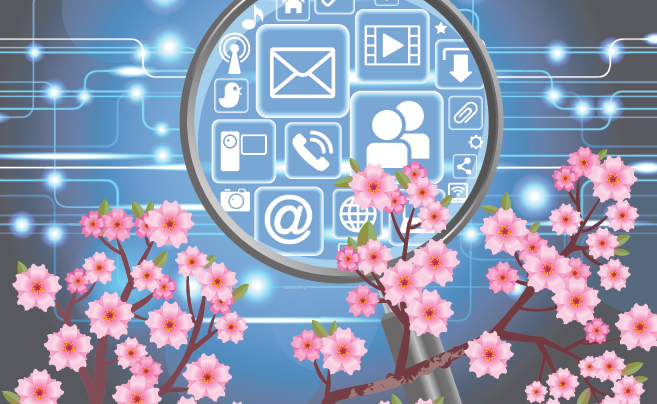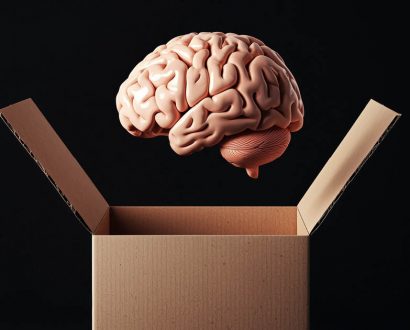This year I travelled to Tokyo to visit our Fujitsu R&D Laboratories during the peak of the cherry blossom season. The combination of creative, natural and technological stimuli I experienced was an intellectual and emotional delight.
Ray Kurzweil, the renowned futurist and Director of Engineering at Google, suggests that technology is advancing so quickly that, rather than experiencing a linear 100 years of progress throughout the 21st century, we’ll experience what feels like 20,000 years of progress.
I think it’s pretty clear that some of the changes ahead are going to be confronting and uncomfortable, and more than likely, we will staunchly resist them at first.
Yet some things stay the same
Excited to be visiting one of the high-tech capitals of the world, I found it strangely comforting to arrive in Tokyo and find the amazing cherry blossoms [sakura] in full bloom at the Shinjuku Gyoen National Garden.

The cherry blossoms are responsible for a spectacular, annual flush of pink that slowly cloaks its way across Japan – from Okinawa in January, to Kyoto and Tokyo at the end of March or the beginning of April. It proceeds into areas at the higher altitudes and northward, arriving in Hokkaido a few weeks later.
This beautiful yet ephemeral blossoming lasts no more than a fortnight – a brief yet unmistakeable signal that heralds the arrival of spring. I witnessed the Japanese tradition of the cherry blossom viewing picnic [hanami] that has survived relatively unchanged since about the 8th century. Friends and family get together in parks and gardens for parties that last well into the night under the pale pink blossoms.
Why was this so comforting to me? I didn’t know.
A little research about what cherry blossoms symbolise in Japanese culture helped me to understand. The brief yet exquisite beauty of their flowering creates a kind of sensation referred to in Japanese as mono no aware. The direct meaning of which is the sadness or pathos of things – which implies the transience of carnal and material life. Yet this wasn’t all I felt.
According to the catalogue for a 2013 show at the Suntory Museum of Art, through the work of the Neo-Confucian scholar, poet and artist Motoori Norinaga (1730 -1801), the phrase has come to stand for, “…sensitive, exquisite feelings experienced when encountering the subtle workings of human life or the changing seasons.”
Letting go of some ‘known knowns’
Whether we like it or not, the wave of technological change we have seen over the past 50 years is only in its earliest ripple. For those of us helping our organisations and customers chart a course ahead, I think this exquisite Japanese concept of mono no aware has some great value.
Letting go of much of what we have learned is difficult and disturbing. It’s also important not to accept all technological change as good, or to assume it comes at no cost to the environment or community at large. For example, the jury is still out on whether genetic engineering of food crops will be good for us in the long run. However, as the pace of change increases, and technology creates new possibilities we have never imagined, we will be obliged to adapt. Otherwise, we risk becoming “road kill on the information superhighway,” as a former colleague liked to put it.
Looking into the (near) future
Facing the facts is helpful. During my visit to the Fujitsu Laboratories in Kawasaki and our offices in Tokyo, I saw first-hand some of the radical changes coming our way:
- The concept of graphene nano-ribbons, which may be the foundation for quantum computing. Quantum computing could enable us to find distant planets, detect cancer earlier, massively improve weather and natural disaster forecasting and help us design super-drugs.
- A data ‘bank’ being established to hold activity data against a comprehensive taxonomy of the more than 6000 things we humans do in life. Secure access to this data ‘bank’ will enable a new breed of personal service providers to help us seamlessly manage our personal health.
- A product design tool being developed to enable designers to physically experience the boundaries and contours of their virtual 3D designs. This technology will allow us to virtually ‘try out’ digital prototypes of buildings, cars or clothing, provide real-time feedback and enable incredibly personalised products and experiences to be created.
- Technology capable of simulating an entire transport system – concurrently modelling the vast number of possibilities when each vehicle (car, bus, taxi) is considered on its own, as a shared ride, or on a scheduled route. The technology would take into account travel and wait times, user preferences and the economics for transport providers. By enabling the taxi industry to cooperate with public transport providers on a city-wide scale, this may well be an Uber killer.
- Gaze tracking that enables us to see what people are looking at on a screen or a shelf, and video ‘watermarking’ technology that uses invisible tags to present additional digital content by just pointing your smart phone at the screen. Using these technologies, broadcasters and retailers can allow us to individually choose how we want to engage with value-added content, rather than simply deluge us with unwanted, undifferentiated advertising.
And this is just the beginning.
Learning to live with big, fast change
Climate change notwithstanding, we can be sure the iconic sakura bloom will cut its pink swathe through Japan each year with clocklike precision. Yet every year, between the serenity of one hanami picnic and the next, we will chalk up more change than the year before.
The symbol of the cherry blossom – the concept of mono no aware – gives us a clue. To acknowledge gently the sadness that may come with changing things we used to or currently know, and to appreciate joyfully the excitement of new things we can learn, and our eagerness to creatively uncover what they can mean for our lives, our customers and our businesses.
Why not make a daily habit of adapting, in lots of small ways, to the thousands of years’ worth of accelerating change that Kurzweil predicts, rather than waiting for the gut-wrenching changes that come with major life and business crises? Equip yourself with the resilience, courage and changeability symbolised by the cherry blossom. You will have much greater resilience to deal with crises when they come, experience more intense joy, learning and personal growth, and be in a position to champion innovation in your business in ways that your change-wary colleagues will not.







